Text
Week 1 -
Tuesday 18th April
In todays session we each pitched our individual ideas. It was a really interesting beginning to the session, especially seeing what everyone had come up with, despite all being given the same brief. There were various ideas, from social spaces to sculptures and water features. My pitch was an interactive light installation. I took into consideration the history of Digbeth, its surroundings and the stakeholders to come to my final pitch idea. I wanted my light installation to mimic water and the way water moves. This was inspired mainly by the use of canals and water transport into and throughout Birmingham/Digbeth. Digbeth was the first area of Birmingham that was settled in and therefore the first to see glimpses of the industrialisation of Birmingham, which began simply due to the accessibility by boat. This part of Digbeth's history seemed important and cropped up a fair amount in my research and so I felt it important to incorporate it in my designing. I also wanted to acknowledge the art and surroundings that exist already, I thought i'd do this by having the blue light act like a U.V light also, so that any of the UV paint used in the arch would illuminate. This therefore highlighting the existing work rather than taking from it. I also considered the different points of contacts and who would be able to see the installation. The arch is actually viewable to me in my current flat, I was watching the train go over the arches one day which sparked the idea of the light installation, potentially illuminating as the trains go overhead. It means those on board can enjoy the sea of blue beneath them, the visitors can enjoy the immersive experience, and anyone watching from afar may be intrigued as to where the luminous blue light is coming from.
After pitching each of the Ideas Lara and Sarah went away to decide which of the pitches would be selected and developed, to then pitch to our stakeholders (Birmingham City Council and OVAL estate). They came back with a list of the groups with group leaders, these being those who's ideas were chosen. My idea was selected, and so I became the group leader for the chosen group. My group formed due to a similarity in each of the pitches that we presented. Each of our pitches highlighted the idea of working with water due to the use of canals in Birmingham. We then parted off into groups and began collaborating to brainstorm a final pitch.
While collaborating I felt as though there was a potential misunderstanding of how we were to collaborate. From what I understood it was my idea that was the foundation of the pitch and then developing this idea further to best adhere to the brief/stakeholder wants and needs. Others in the group, however, seemed to think it was a complete new idea, meting all aspects of each design pitch together. I felt as though this afternoon my job was to listen and try and ensure ideas are all welcomed, but maintained to a realistic level.
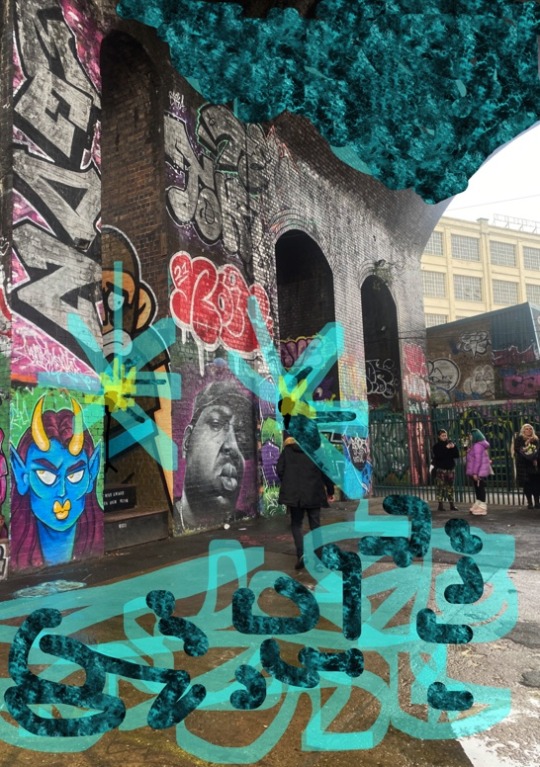
Friday 21st April
On this Friday we continued sharing and developing ideas and clarifying our final outcome. In this session I tried to share concerns with the potential that our group was getting slightly carried away. It seemed that every idea that was shared, was then added to the design idea. It seemed that because it is a speculative project, a few members of the team got slightly carried away with that. I preferred the idea of constructing a more simple idea and developing from there, rather than trying to combine so much, so quickly. It was also difficult that when stating my queries with losing a certain grasp on realistic designing, I was faced with a fare amount of stubbornness from certain individuals. I knew this may be a trouble when assigned the group leader, however, it was more difficult than I had experienced previously. I then had to discover ways in which I could work around this to try and achieve a more realistic outcome. The outcome we came to was an immersive interactive installation. There was said to be an inclusion of bioluminescent feature as there is natural bioluminescence in nature, however, I didn't feel as though this fit well with the installation theme, that was ultimately based on the usage of canals and water ways in Birmingham. Some members of the group also wished to work with a live water feature, this seemed possible which meant we further considered the idea. The final feature that we developed was the water screen feature that Ash pitched originally. This, to me, seemed slightly unrealistic for this specific site, as these tend to be featured in much larger scales with very large budgets. However, they were certain the logistics were okay and so we continued to develop the installation with the water feature.
In this session we also did small progress pitches in front of the class. Here we shared what we had so far done and our collaborated ideas. These are very useful as its nice to get feedback from an outside opinion. It also helps verbalise the ideas and learn from the reaction of our fellow classmates and tutors. The advise and criticisms are always welcome, especially when practicing and voicing our pitches as, this is all practice for the final pitch.
0 notes
Text
Speculative Lab Launch
Friday 31st March
Today we launched the speculative lab. We began the session discussing the reading texts for this week, each discussing speculation and examples of speculative design. We were also introduced to the pink chicken project. This project set out to genetically modify chicken's gene coding, so that they're bones and feathers begin to appear pink. This then meant that once passed, the chicken bones are discoverable as they remain pink, even after fossilisation. The project pitch went on to further discuss the context of the project and that it also intends to send a message to future geologists that may discover these modified bones.
After discussing the texts and projects, we went through the presentation for the session which was the general launch of the project. We discussed Birmingham City Council and their public art strategy, as well as Oval (the real estates for our site) and finally the site of our design project, Floodgate Arch in Digbeth. The site is a an arch beneath a train track that is full of graffiti and colour. Once being introduced to the site and looking at images of the arch, we were given the brief for the project. Which was, "Taking inspiration from your stakeholders, their needs, and your given site, develop a speculative pitch proposal for either a temporary or permanent piece of public artwork, event or intervention." We were given the next few steps in the project, to visit the sight and gather research for analysis such as; images, videos, and sound recordings. As well as to research our clients, these being Oval, the City Council, and the local community.
Jason then gave a presentation about his experience in designing speculatively and what it means to him. It was definitely interesting to listen to someone with such a rich experience in working in such a way. He spoke through pitches he had made of various projects, which again was interesting to see as it was very real, very professional examples of speculative project pitches.

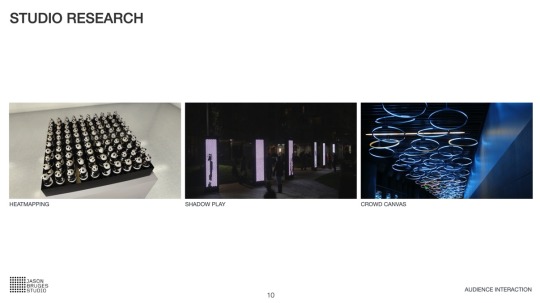


In afternoon of the session we collectively took a trip to floodgate arch in Digbeth. Here we observed the site in which we'd be working on. We collected primary images of the site that we could refer back to in our designing and planning. The site itself was very exciting to me. It was filled with impressive graffiti and artwork that I was immediately drawn to. I was sure to not only focus on the existing artwork, but to photograph the entirety of the structure, so that I can be reminded of the size and shapes within the arch's architecture. I recorded images of the site itself and it's surroundings. I wanted to have a clear vision of the entire space as it may influence the concepts I later develop. Surrounding the arch is; the canal that flows beneath/through, the train that goes overhead, and of course the creative hive that is Digbeth. I also recorded sounds from the arch, the day we went was a fairly wet day so the trickles of water were a focal point of my sound exploration, I wanted to record sounds from the train above, however, didn't quite manage to capture the train passing in time. It was a very useful trip, to see the site up close seems crucial to fully understand the space in which we are to work with. I particularly liked that we were given the brief in the morning and spoken through the task, so that when visiting it was clear what the requirements were, and we could start planning and considering ideas in that moment.
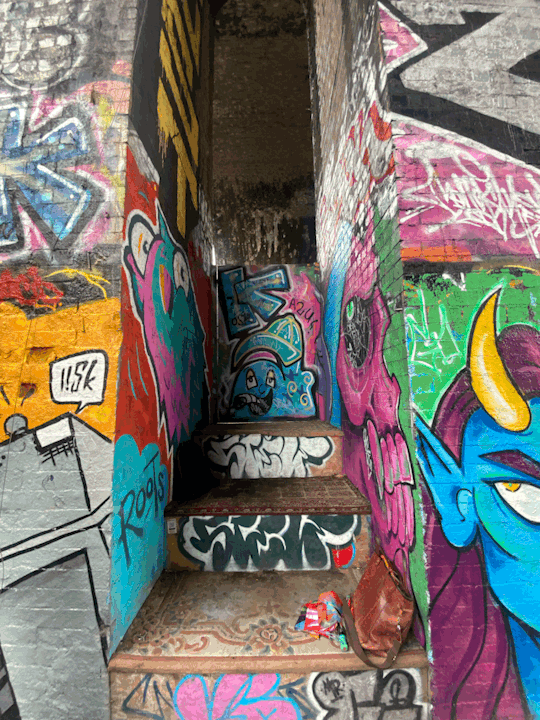



0 notes
Text
Week 9 - Final Week!
Tuesday 21st March -
Today we planned to finish printing the book, confirm the order of the pages, bind the book entirely together, test the video projection and sound, and finalise the set up of the performance. We began by using Leila's account on the pc to print the rest of the book. We somehow miscalculated the amount of paper we needed and so spent time scouring the studio for more of the same kind, which luckily we managed to find. We then continued to print off the pages so we had the whole book fully printed now. With the pages that we had we hand wrote any remaining poems on the corresponding pages. We wanted to use the robot writing tool and the software, to write using each our mothers hand written font, however, there was some sort of technical error and despite Sarah replacing the motor in the machine, it wasn't able to work again. We instead printed a few and continued to hand write the rest in.
The studio was fairly busy today with everyone setting up and getting the remaining jobs done for Fridays session. We ran through the set up of the performance and even got the lights programmed to the colour and setting we liked. We chose a soft amber colour at a dimmed level as we felt it mimicked a golden sunset and enhanced a certain ambience which felt calming, ultimately how we want our audience to feel. We also finalised where we wanted the audience positioned and the kind of stances/positioning we would be as the performers. We also practiced projecting the video that I had taken as a practice for the final video that Meg is making. This was all successful and so we were closer to being complete and ready for the performance.
Once the set up was established we had come to the end of the day, we had to bind the book and configure the order of poems and art work. We made a plan to come in tomorrow to ensure it is all put together and rehearsed ready for Friday.
Wednesday 22nd March
Today we came in for a few hours and made a plan for the final presentation, we worked on this on a google slide document as this meant we could work communally from different locations. We planned through the presentation and what we wished to include. We also finished binding the book together so that it was now complete and ready to be displayed. We set up the stage space with the seating how we wanted it, in a semi circle surrounding the stage. We chose to have the majority of the audience on the bean bags as we wanted it ti feel as if we were almost telling the audience a story in the same way you may read a child a bedtime story. This was to highlight the sense of comfort to the audience. We had our performance objects in front of us so that the audience could see the inspiration for some of the poems. One of these objects being Leila's oil diffuser which was on as it added a scent to the scene which further enhances the sensory experience we were curating. We were happy with the set up and so began rehearsing the poems and checking for timings, ensuring the book was fixed in a place accessible to all and it was fully functioning. After a few runs we were happy with the performance and just had left the presentation to complete. We were adapting the presentation that we had added to throughout the project and so it wasn't too difficult. We wanted to make it as visual as possible and so used mostly images so that we could speak through each. I prepared queue cards so that I could remember the important points I wanted to make for each slide. Each slide has a little illustration that indicates which of us is to discuss that slide and so we can each make our own notes.

Friday 24th March - Performance Day!
Today was the day of the performance and presentations. I felt our performance went well. There were no big technical difficulties and though it was very nerve-racking, I felt the group and I were successful and delivered in the way we each intended. It was a very interesting day watching what each had come up with. There were various different performances, from interactive games to acting and storytelling. It was really nice to see such a different style of art and design in practice. Our presentation also went well. I did feel it was fairly evident who within the group may have not thought out what they were going to say beforehand, however, I think that the information we discussed was relevant, and that the use of images meant that it was easier to follow too.

Group Miro:
Final Presentation:
0 notes
Text
Week 8
Tuesday 14th March -
In Tuesdays session we began the day by checking on our paper. We went down to the workshop and saw the dried results. They each worked fairly successfully. even an experimental piece that we made by joining various sheets together using the paper pulp mix. After observing and collecting the pieces in we had to then flatten them as best as we could. We did this using a large old fashioned press. The sheets were stacked on top of each other between two pieces of felts. The press is then lowered as far down as it can go so that the paper is flattened as much as it can be. We left the sheets in the press then to be collected later in the week.
We then continued making the contents of the book. The aim of today was to get all of the artwork that we were including uploaded onto a google slide so that we could then print it off. We had been debating how to print the artwork. We considered screen printing, and getting it professionally printed at the Curzon printing shop, however, these each seemed to be fairly costly and so we thought we'd print it ourselves from a p.c. We did, however, spend time selecting the best paper for the book. We wanted something that looked natural, as the made paper that was being used for the front and back cover had a natural look to it. We used a stash of paper that we found lying around in the studio, it was A1 and so we had to chop each sheet down to the desired size.
Throughout today's session we also experimented with, what we called, a robot arm that would write words that it was programmed for through a software on a connected laptop. Mukki discovered the piece of equipment in the studio and decided to experiment with it and we all enjoyed it too. We were able to programme it to write out Mukki's poem. We thought about ways to tie it into the themes from either the performance or nature lab and then came to the idea of making our own fonts. Because our performance objects each have maternal links too, we thought we could try and retrieve a font in our mum's handwriting. Meg then took charge of changing the fonts as she had ,managed to successfully do hers in todays session also.
Friday 17th March -
In today's session we were focusing on, collecting our dried and pressed paper, binding the pages, printing off the contents of the book and devising performance. We started off by collecting the paper which was flattened as much as it could be. We then considered how to bind it and despite previous research into Japanese book binding, we had to simply stitch the sheets together, which proved fairly tricky as the paper was thick, and it was difficult to pierce then thread the thread through. We also had to consider the shade of thread that we were using. Mukki managed to find some thread from the textiles workshop. This thread was white, however, and we didn't think that it fitted the aesthetic of the book in the best way possible, and so we looked into dying it. We used recourses found in the studio. We tried black ink, red food colouring and coffee. This experimental method of dying the threads reminded me of the natural dyes workshop that we did, and it was useful in that sense as without having done this workshop, we may not have considered coffee as a dyes to use, which ended up being the dye we selected, it gave a neutral brown shade which we felt was the most natural looking.
After binding the individual sheets together to create the front cover, Jess began the writing on the front cover of the book. We chose the name Mother Nature as we thought that combined both of the labs perfectly, as well as hinting subtly the sorts of themes of the contents of the book. For the rest of the session Meg compiled a video of the audio and video that we wished to have played and projected throughout the reading. Mukki wanted her poem that was being sung to be recorded and then played in the performance so we ensured that was incorporated into the video that was to run throughout. Meanwhile Mukki and myself started printing off the pages on the selected paper. I cut the paper to the size we all agreed and Mukki ensured it was printing successfully. We managed to print the majority successfully until Mukki's credit ran out, we then had to switch from her account to my account and then to jess' account until we each had no credit and no more members of the group in uni. We had to wait until Tuesday to continue the printing but, managed to print the majority of the book as planned.
0 notes
Text
Week 6
Tuesday 28th February
We began today's session with a screening of Netflix's documentary, 'My Octopus Teacher'. We watched it due to its relevance to the nature lab. It showed evident examples to networks in the natural life, as well as human relationship to nature. The relationship between the filmmaker and the octopus grows so intensely, and as a watcher you see the genuine mutual care for each other. It was a very wholesome and eye opening watch as it shows just how close to nature we are and can be, however, we as humans don't appreciate it.
For the rest of the session we continued developing our ideas for both the performance and nature lab. We proceeded to draw our nature objects in the same depth we did our performance ones so that we got a full understanding of each of them. I took this session to try something new and rather than working with materials that I was used to, like I did in the performance lab, I used one of the iPads and procreate to experiment with that. At first I found it slightly difficult, but like anything it became more familiar and so I felt more comfortable working with it.
During this session we also went back to the print workshop to discuss booking in a workshop slot to make our paper. We spoke to the technician and got a slot sorted for Friday 3rd March. He did however, say that we'd have to come in to prep the scrap paper that will be turned into our sheets of paper. Me and Jess said that we'd come in to make sure everything was ready for the workshop on Friday.

Thursday 2nd February -
On Thursday, Jess and I went into the workshop and with all the scrap paper collected we began ripping it all up into smaller chunks. We then transferred the water to a bucket and had to fill the water up with water. This was then to be left overnight so that the following day the 'pulping' stage would be faster and more effective.


Friday 3rd February -
Friday's session began with a discussion about the entangled life text. This piece of text discussed various aspects of the natural world. I remember especially it mentioning fungus and and its spread, followed by a few images of various kind of fungus. This reminded me of the slime mould workshop that we took part in last year. I also felt it had clear links to the idea of a network and a trail all in one space. It almost creates its own trail/ pathway as it grows and spreads with various new branches. It was nice that the text had corresponding images alongside the content. It at times was very technical and so to have those visuals to refer to made it slightly easier to read.
After the mornings discussion of the reading work, my group and I went down to the workshop to begin our paper making. We firstly had to pulp the wet paper mix that me and Jess had previously prepped. We were going to begin putting leaves in at this stage but the technician advised us that it may be better to place them into the paper as we begin laying out what will be the sheets, as this will allow the leaves and other natural elements, to keep their shapes better. So we began the pulping stage with, what seemed like, a big blending machine that pulled the water and paper mix through so that the recycled paper was further broken down, we added more water so that the existing paper was fully sodden and the mix pulled through the blender easily. It also made sure that the mix wasn't too thick. Adding the water to the pulp was a variable that we had to ensure to note down as we didn't want to lose track of the amount of water used and then add too much. As well if we needed to retry this process at any time, we wouldn't have to guess as we recorded a successful method to start with.
This process was to be left for an hour or so, and so we went back to the studio and used this time to continue our poem writing, and nature lab drawings. We experimented with an A.I poem generator. This took in key words and then wrote a poem using the keywords and their individual semantics. I liked this generator as a foundation for the poetry that I wrote, however, some of it didn't sound the way I'd like and so I'd use the generator for base ideas but then developed and adapted the poems, in a similar way to the 'blacking out' method that I'd done with pre existing poems.
After a while we went back down to the workshop to continue making the paper. To do this, we took the mix that had now been fully pulped, mixed it gradually with a bit more water in order to thin it down, and shook it through a small, sieve like, screen. This then allowed the paper fibres to knit slightly back together as they were pushed together while the water drained. The screen was then placed onto a piece of fabric so that the paper mix layed flat on the fabric, and the water was able to drain. This process was then repeated with the rest of the pulp mix. We got more comfortable with the process and so began experimenting placing our found natural objects into the paper. We tried this with leaves, that stuck particularly well, and different twigs we'd found. We also thought it could be interesting to add lavender into the mix as this not only would provide a nice texture but a nice smell to the book. I and the rest of the group each also said that the smell of lavender reminded them of their childhood as it is used to help with sleep. We felt that this was a perfect addition to the book as it enhanced a comforting atmosphere for the reader. We also tried coffee in some of the pages, just to see if the scent would stick as the paper dries. Creating a sensory experience for our audience seems important, as Leila's performance lab object was an electric oil diffuser, and this was associated particularly with a calming atmosphere as it emits scents and colours.
Once we had used all of the pulp material, we had to squeeze out any excess water so that the paper would stick together better. We used an old fashioned heavy duty press that pushed each of the pieces down so that the water drained out of the sheets. After the water was pushed out as best as possible, we had to lay each individual sheet out on some news paper so that it would dry. We had to then leave the individual sheets out to lay flat for a few days so they'd fully dry.


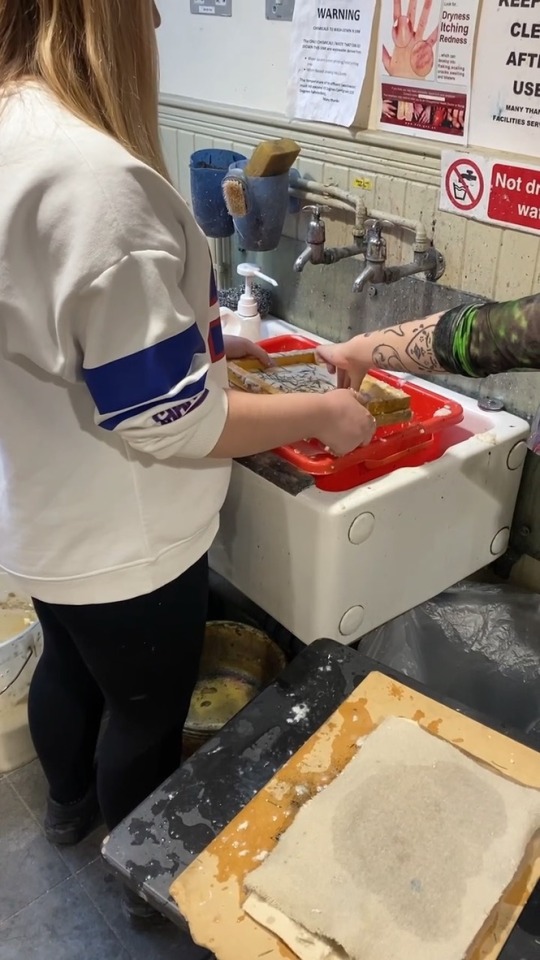


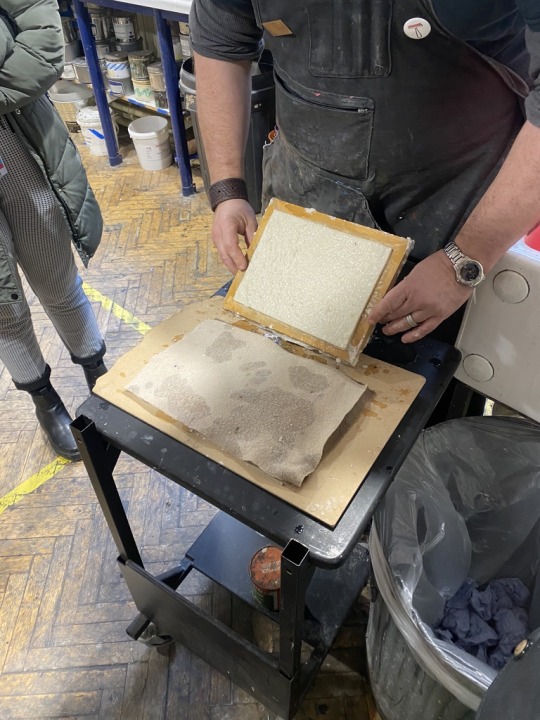
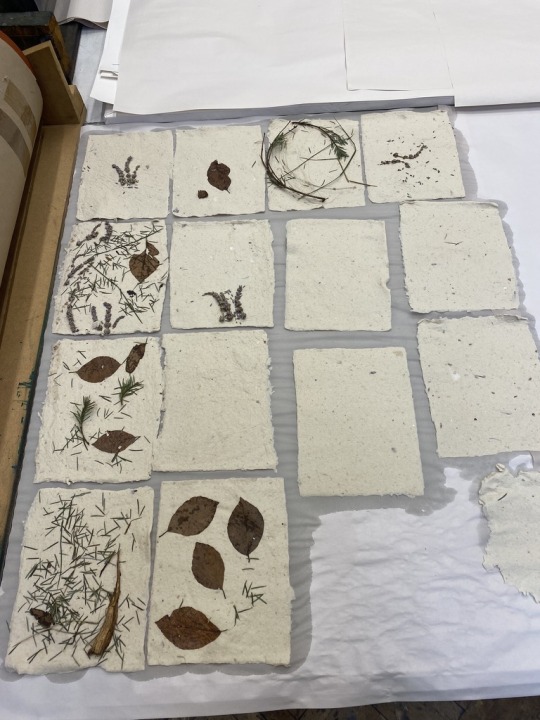
0 notes
Text
Week 5
Tuesday 21st February
Unfortunately I wasn't in the studio for this session due to illness, however I was sure to catch up on work missed outside of the scheduled studio session. I went through the power point and remained in contact with my group so that I was aware of what they were doing that day, and I could therefore catch up at a later date.
The presentation discussed sustainability and working sustainably. We discussed what it meant, to 'keep something going or provide support'. It can be applied to various settings such as, preserving life and protecting the environment, however in a practical creative sense, it can denote any action that has little to no impact on the living world or natural life, including humans. We learned that there are 'three pillars of sustainability', these are social, economical and environmental. These kinds of sustainability focus on the wellbeing of the environment and therefore human health, as the benefits of working consciously with the environment effect the overall quality of the environment and therefore human health. The power point also discussed ethics, and noted that ethics are no longer a desirable choice designers may or may not make, but a neccesity and an ethical imperative. We were introduced to a 'Future Materials Bank' this was a particularly interesting element to the powerpoint as I hadn't previously heard of it, but it seems as though it'd be extremely beneficial. The website consists of an archive of different kinds of ethical materials that have been discovered by makers across the globe. Each of the materials have been tried and applied to see how they work. It was actually really interesting to look through the bank and see what people have explored and how they became successful in their experimenting. It was also nice to see so many people testing new, natural materials to ensure their (and hopefully future designers) practices remain ethical.
For the rest of the afternoon my group began sharing and discussing the objects that they each collected from the Wyre forest trip. They began to photograph the objects and discuss them in relation to the brief set. I was sure to look over the objects and see if it sparked any ideas and how each object related to the brief. I collected a variety of fallen objects in the forest such as a pine cone, various leaves, twigs and interesting offcuts. I also recorded various areas of the forest, capturing still and moving images such as, a small stream, birds chirping and flying and various other moments. We each shared the resources that we collected, the images and videos via an online group chat and the objects physically shared between us to each observe. We then started to familiarise ourselves with eachothers objects as well as our own to see what ideas we could spark.
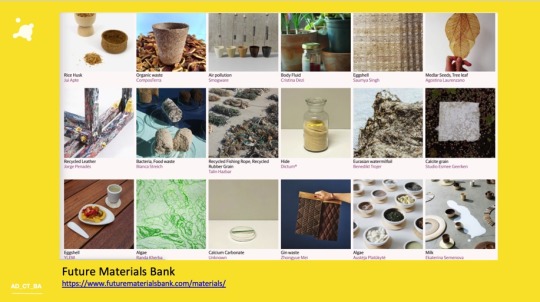
Friday 24th February -
In this session we again began by discussing the two reading texts of the week, each of these discussed trees and their importance. The second also began to discuss climate change and the future of trees, where as the first mainly spoke about the importance and function of trees as a species. They each showed great relevance to the nature lab, not only because they're trees and an essential part of nature but because, as discussed in Tuesdays session, trees are heavily reliant on for various materials to be made from, as well as a crucial element of survival for mankind and most existing organisms.
For the rest of this session we continued familiarising ourselves with the objects collected and brainstorming ideas. This time with group tutorials so that we were able to discuss our ideas so far. in this session we discussed taking a similar approach to the project as we did performance lab, and so began photographing and drawing experimental drawings of our objects. We also spoke about the kind of outcome we may produce. We began to brainstorm ideas and had the idea of combining our performance lab with the nature lab. This was mainly due to the fact that they complimented each other so well. The common theme from the performance lab being; comfort, family and homeliness, which, we thought complimented the themes of nature and ideas of a natural habitat where your most at ease. The sense of peace that you feel when in your natural setting, and a physically natural setting seemed harmonious and so we decided to explore that together. After discussing this we began to brainstorm further and consider what we had so far discussed about the performance lab, which was, that our performance would be a poetry reading from a handmade poetry anthology, focusing on the idea of comfort, brought about by our performance lab objects. We'd also discussed making paper for the book as a symbol of environmental awareness as we would be using recycled materials. I remembered in the workshop the technician talking to us about the paper making process and saying that leaves and natural waste can also be used to make the paper and so we felt this was another way we could physically embed the idea of natural forms throughout the performance. We discussed writing a varied series of poems surrounding both comfort and home and the nature lab/ our findings, so that the natural element and comfort element of the book are thoroughly integrated.


0 notes
Text
Week 4 - Nature Lab Launch
Tuesday 14th February
Today we launched the nature lab. In this session we were spoken through the nature lab and what we were to do. We are to work collaboratively 'applying thinking through making using found materials in the natural environment'. We looked at themes that we could explore through the projects, these being; maps, trails, and networks. We were shown different pieces and installations that were each relevant to these themes. I particularly liked the Jason Bruges studio work, 'nature trail' and 'life in the dark'. These were each interactive installations with relations to nature. The 'nature trail', was an interactive wall that would sense human presence and show an illuminated animal, the animal would then follow the person as they moved past the wall. It was made in order to help young patients in hospital as they go into theatre, this was another reason as to why it was my favourite example as it had really positive intent when being created. After looking at various examples we were given the group challenge for this afternoon which was to begin our research in discussing the suggested themes. We spoke through the plan for Fridays session which was a trip to Wyre forest to collect materials for the nature lab to study. These suggested materials included sounds, film, photographs, illustrations and even physical materials.
In the afternoon of the session we had a visitor in. She came into the studio and carried out a natural dye workshop. She spoke through her experimenting and practice with naturally dying fabrics and even showed us some of the various samples she had collected. It was nice to physically see the various shades she had retrieved through dying with various different resources. Today however, We used avocados, onions and weld (various flowers leaves and stems that had been dried). Each of the natural products were dried previously and then added to a pan of water to then be brought to boil. We also submerged the fabrics in which we were dying in water and left those to boil. Within each of the dying tests there were three further tests and that was mixing different chemical compounds into the pans sop enhance the pigment in the natural dyes. After both fabrics and natural products had been boiled the solid products had been removed from the water and the fabrics then slightly dried to be resubmitted,ereged into the dyes that had been created. The fabrics were then left to soak in the dye while continuing to be heated and occasionally stirred. The process took all afternoon but the results were very impressive. Each of them left quite vibrant colours. The best results were from the weld and onions. The onion giving a mix of both vibrant and deep red/orange shades and the weld a variety of greens. The avocado, though pale gave a very pretty, pale pink/blushed shade. The workshop was a very interesting way of working and taught us of a new way of working while incorporating natural raw materials, this linking perfectly to the new nature lab.
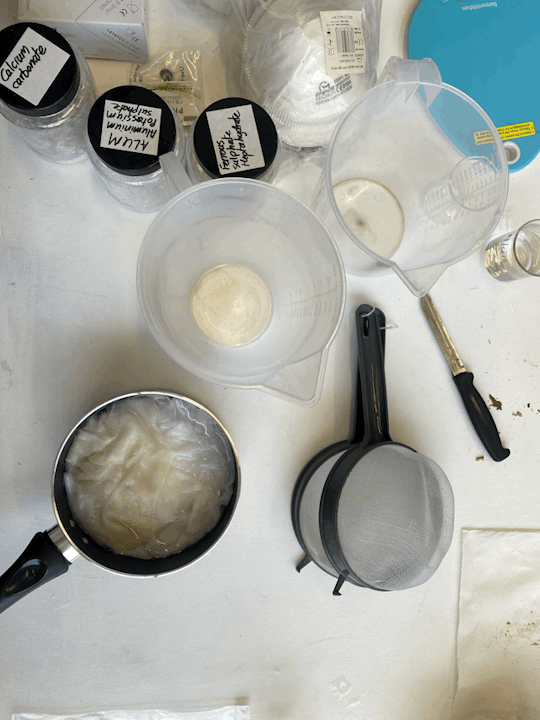





Friday 17th February
Wyre Forest Trip -
Today we took a trip to Wyre Forest in Worcestershire. Here we were to explore the forest and collect a variety of primary resources from the forest. We were to collect recordings that we could then use in our nature lab project. I enjoyed walking through the forest on the various tracks and searching for different things to collect. We looked out for things such as different pathways, interesting plants and trees, and sounds. Anything that we thought was interesting we could then photograph/video or collect to then use later in the project. I enjoyed collecting various sounds from the forest, I found it particularly therapeutic to stand and simply just listen to the sounds in the forest, from people talking in the distance, to dogs barking and birds chirping. It was enjoyable to stand and listen out for interesting sounds and stop to appreciate them which I think, now, is too often forgotten to do.

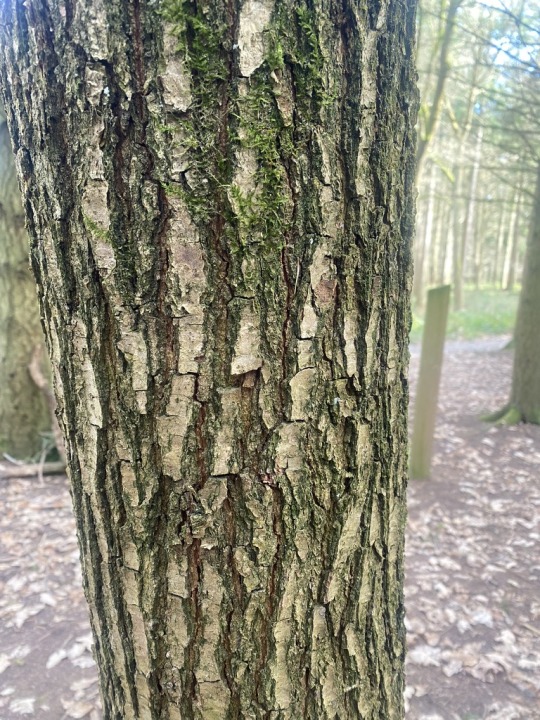


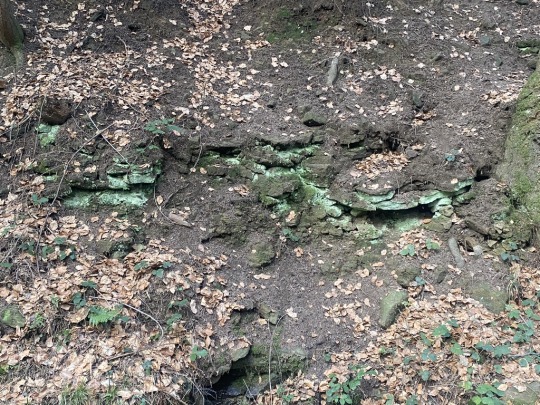
0 notes
Text
Print Workshop Induction
Wednesday 8th February
After feeling particularly inspired by the poetry book 'Every Word You Cannot Say', my group and I wanted to look into printing. This is because the book consists of not only poetry but printed illustrations that express the themes addressed in poems. We wanted to look into the facilities, and consider the potential to create our own prints alongside poems that we will write.
We were guided through the printing workshop and introduced to the kinds of equipment that is used in there. There were various stations and technologies in there that are used to help printing from; wet ink printing to large and small scale screen printing, etching, mono printing, paper making and many more. We were shown the various ink stations and the old fashioned presses that are used to add pressure to various kind of prints. We, however, became quickly intrigued by the idea of making paper. We spoke to the technician who said that we can make the paper using recycled papers and include leaves, which we then saw a potential for connection to the future nature lab, as well as the poetry book that we were initially inspired by.

0 notes
Text
Week 3
Tuesday 7th February
Todays session began with an introduction to Semiotics and Character Design. We learned that semiotics was a 'tool for analysing how signs function symbolically in society.' . Signs can be made up of words, images, sounds, odours, flavours, acts or objects, and we are left to infer and interpret their meaning. While we were discussing signs and semiotics I couldn't help but consider the relevance to symbolism and consider the difference between symbolism and signs/ semiotics. Only that semiotics is the tool used to analyse signs and so could potentially apply also to symbolism. I think this came to mind particularly due to the fact that I've recently been introduced to so many aspects of performance that are so carefully considered and included, and whether or not they are especially symbolic/important.
We moved on through the presentation to look at semiotics in character design and costume. An example we were given was the Harry Potter character Dolores Umbridge and her intentionally increasingly hysterical. We discussed how the designer, 'Jany Temime' began with pale pink tones and gradually made the shades she wore darker and darker to mimic the growing hysterical nature of her character. These selective choices made behind the scene of performances are definitely something I'm growing more interested in during the performance lab, it's interesting to understand the finer details and decisions.
We continued to discuss costume and how it shapes and adds to the characters as well as 'supporting the narrative [to bring] characters to life'. We were introduced to a few examples in film where costume adds particular effect. My favourites that we were shown were probably a frame from Hidden Figures and La La Land. Each of these films I have seen and so can understand how the selective choices add to the story. In hidden figures we see a pop of colour in a room of plain, repetitive colours, which immediately draws your attention to that character. As well, we were shown parts from the musical La La Land. This was interesting to me because I remember specifically this film having especially outstanding colours in the costumes.
For the rest of the session we continued with our group work. Throughout the first few weeks of the performance lab we'd each been focussing on working with our objects experimentally and creating pieces of art that capture the common themes of each of our objects. Because we had also discussed types of performance art we had each mentioned that we liked poetry as a kind of performance art and so Meg bought in a few poetry anthologies for us to look through for inspiration. There was one in particular that we each liked as it was pieces of poetry alongside illustrations and relative artwork. This then sparked interest within the group to consider poetry reading as a potential point of performance for our final outcome. I began plotting ideas for poems and considered a method for making poetry that I had previously done which was creating poems from poems. This is done by 'blacking out' parts of the text and leaving certain words to eventually leave a new poem behind.

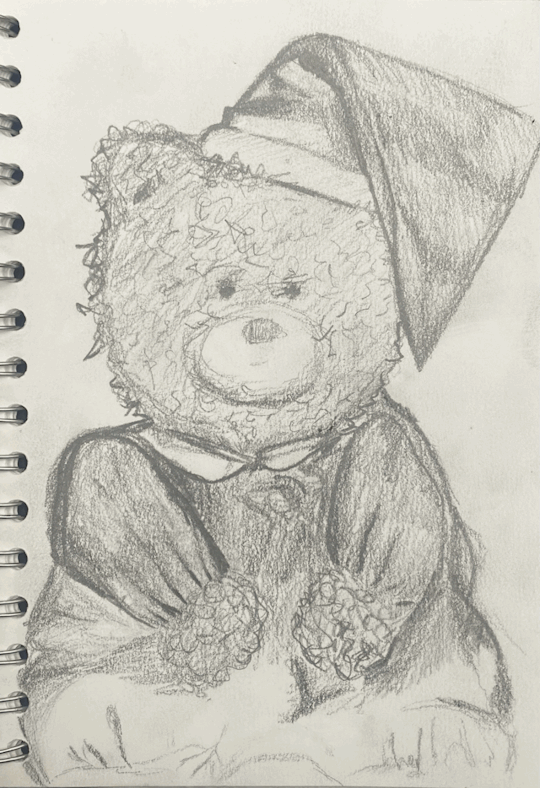


Friday 10th February
On Friday we continued with our collaborative creations. Within our groups we continued exploring our objects through experimental drawings. I did a quick observational pencil study of my object as well as completing a piece I had worked on which consisted of drawing around my teddy like a stencil repetitively and then colouring in overlapped spaces, this actually became a favourite of my pieces as it felt the most playful and had a nice repeat print look to it. We also drew/painted our objects with our objects, because I didn't want to use my teddy with ink I instead found a material with a similar texture and began painting using this fabric. This also created a nice and truly experimental piece.
In the afternoon of this session we prepared a small presentation of the work we had done so far, so that we could present our ideas to the group. We uploaded our research and mind maps from each of our object analysis, as well as the art work we had each completed in this week. We were also able to show our research into performance and our final conclusion to look further into poetry. It was a nice way to collect all our ideas and research in one place, and to talk through our ideas is something that I find always helps in solidifying the ideas we have so far come up with.

0 notes
Text
Improv Workshop
Wednesday 1st February
In todays session we were agin working with Jon Trevor in an improv workshop. In this session we again played various games and attempted different challenge, all in attempt to help us with our presentation skills and talking in front of a crowd. We looked at methods of storytelling and what makes a story interesting to listen to from the audience perspective.
We worked in a smaller group today, and I found it was useful as we were able to repeat processes to better our responses to the tasks. The tasks gave me quite a refined view of the kinds of information that is best to share with the class when we present in future. This was especially useful because, in my assessment feedback from the previous module I was told to ensure the final presentation isn't too wordy, so the information remains relevant and responds appropriately to the brief in reflecting on the project. It reminded me to ensure that what is said in the final presentation is all relevant, as well as what is delivered to the audience in the final performance.
0 notes
Text
Week 2
Tuesday 31st January
In this session we were looking at visualising narratives. We looked at various projects and studios and the way they began to develop and visualise the narratives and production of the projects. We looked at examples such as Rae smith's 'War Horse' and the storyboard that she created at the start of the project to organise her ideas. We also looked at Tom Piper's Blood Swept Lands and Seas of Red. This one was particularly interesting because the original drawing was such a rough sketch in comparison to the final design.
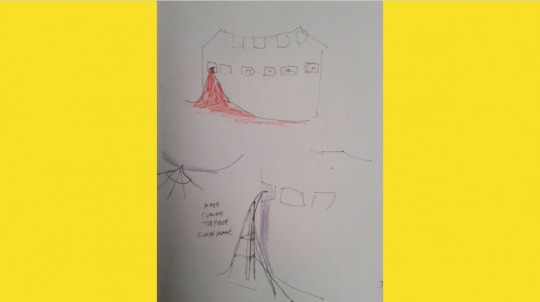

Another project that I was particularly interested in was the Es Devlin Beyonce Formation Tour. This again showed her design process and her initial sketches and ideas. It was fascinating to see where the ideas originated and how they unfolded to become the outcome it did. It was interesting to appreciate the rough sketches that she drew and how they blossomed into the large scale famous pieces that they did.

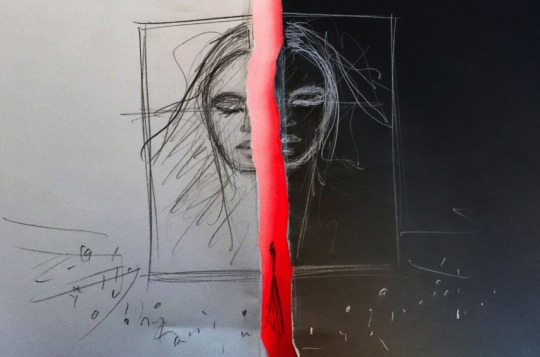


For this sessions afternoon we had another guest in. This guest was introduced again in regards to the performance lab. The guest today was Jon Trevor, an improv performance artist. He came in and briefly discussed what he does, and quickly had the group interacting and playing various improv games. I felt it really brought the class together and allowed people to step out of their comfort zones. It was especially useful in terms of not taking ourselves too seriously in terms of performance and speaking publicly. He introduced us to the concept of not trying to be different and standing out, but in fact using our initial thoughts to create what we primarily gravitate towards as that is what we're truly thinking and feeling.
Friday 3rd February
In this session we were looking at audience and space. The two chosen texts for this week also discussed audience and space and so the discussion of the texts was a nice introduction to the lesson. We looked at different studios and how they used space and audience to enhance their performance. It was interesting to see how different performance groups used space to construct their performances, and how they specifically considered such positioning of everyone involved in the performance, both audience and actors/performers. We looked at different styles of audience positioning, such as; Proscenium, Apron, and Thrust, In-The-Round. We looked again at the Punchdrunk studio and one of their performances, in which they had the audience 'on the move' and also in masks. I think this is a clever element to the performance to include and entice the audience entirely as they almost become part of the performance and characters. It was definitely something that stuck with me in terms of debating my own ideas of audience and how to involve and interest them in our group's future performance.

After splitting off into our performance groups, we were given the task to discuss our narrative ideas in correspondence to our space provided, and our audience. We were given scale plans so that we could visualise various audience placements and how we could use the space. We decided our audience was fellow creatives, those of a similar age potentially, but mainly those that have a particular interest in creative performances and art. We used the scale plan maps to discuss and draw various positions in which the audience could sit or stand, and debate which would be most beneficial in displaying our performance. I thought that this session was interesting as it highlighted another element of performance that I hadn't ever considered in such detail, but it was most appropriate. The way an audience is positioned and/or incorporated in a performance changes their whole perception of the overall performance, and so how they view the performance is just as important as the content being displayed.
0 notes
Text
Model Making Workshop
Wednesday 25th January
On Wednesday we were in the studio again with a technician Lee who lead a model making workshop. In this workshop we built scale models of our studio and a framework structure that acts as a dark space within our studio. This was definitely a useful workshop, especially in terms of performance. We can now use the studio models to plan and discuss stage management and position . We learned especially the importance of taking time and care in our making as we used lots of precise measurements for the scale models.
0 notes
Text
Week 1 - Performance Lab
Tuesday 24th January
On Tuesday we began the full launch of the performance lab module. We were introduced to the idea of creative processes. We watched various videos on creative process. One that I particularly enjoyed was a TED Talk by Sir Ken Robinson on whether or not schools killed creativity. He discussed the creative process in regards to performance. We were then introduced various creative studios that work with performance such as Punchdrunk. We looked at some of the work they do, their immersive installations with actors and plots. They were a very interesting example of a kind of performance art and one I hadn't come across before.
After the launch we were then sent off into our new collaborative groups. We set up a communication method and communal work spaces like Miro and Google slides. We discussed our individual narrative objects and the personal story behind them. In our group we had, my teddy, Jess' charm bracelet, Meg's mannequin, Leila's diffuser and Mukki's headpiece. Between each of the objects we found the commonalities to be that they each hold sentimental value and all correlate to a sense of comfort. We began to further brainstorm the similarities, and the potential ideas from the similar themes between the objects.
For the afternoon of this session we had another guest in, Antonio Roberts, who came to discuss his work and current practices. He introduced us to glitch art, Installation art and live programming performances such as live visuals and music at algoraves. Programming performances were completely new to me and so particularly interesting to learn about. Using programming to create sounds and eventually music was very impressive. After discussing his journey he actually demonstrated live programming and used a series of coding that he'd created previously. He also did a completely spontaneous live performance of random coding sequences that again came together to create a piece of music. This being the kind of techniques that he uses at algoraves. He also stated that he creates visuals that he pairs with the music, varying colours and movement patterns to coincide with the tone of the music. It was a very insightful presentation and an interesting style of performance art, especially because it was one I had never previously heard of.
Friday 27th January-
In todays session we began by discussing the two selected texts that were about performance and devising. This lead nicely into the powerpoint that we were spoken through, again discussing performing and devising. The texts suggested 'Devising is a method of making performance that is often non-text based and includes the collaborative participation of the whole creative company'. This quote was referenced again in todays powerpoint and I think it was a particularly important quote, especially because I had never previously looked into the method of devising. We looked at different studios and projects that people carried out, that exemplify devising and performance. We looked at Cage and Cunningham, a duo that each collaborated on music and dance pieces that were prepared and created together but conceived independently. I liked this example because their work was heavily inspired by everyday sounds, actions and movements. I like that their work was inspired by simple everyday activities.
After looking through a variety of of studios and projects we went off into our groups and began devising as a group. We were given prompts such as maybe writing a storyboard, drawing a visual storyboard, a sound storyboard and a movement storyboard. We each began to discuss potential narratives and methods of combining that with performance. In our group we mind mapped a lot of our thoughts and the ideas that we had. We had an interactive live miro page, however, we found that we worked better when all working physically on the same documents together so that we ca talk through our thought processes and the reasoning for our ideas. This was a useful session in terms of debating performance and continuing collecting our thoughts.
0 notes
Text
Performance Lab - soft launch
Tuesday 17th January
Today was the soft launch of the performance lab. In this session we had a guest in, The Head of Institute, Nathan Tromans. We were advised to bring in interesting objects that hold sentimental value or a 'story' that when hit or touched in a certain way make an interesting sound. We began the session with an introduction to Nathan's work and the kind of things that interested him. He discussed an interest in journeys, music and photography. I particularly enjoyed looking at his images and photographs of a project he completed called "The Blue Road", inspired by Eggleston and his individual admiration for the 'romance of the road'. After a glance at his photography work we looked into the concept of sound within images and how he felt sound was equally important. We looked at the 'Art of Foley' and how different objects can be used to create sounds that mimic completely unrelated actions. After an insight to his work we split off into randomly generated groups and began to compose our own stories using sound and a collaboratively constructed narrative.
Here we began experimenting with our objects we had brought in from home. My object being my childhood teddy bear that I've had since birth. This object created a somewhat washing sound as the beads with inside the bear moved together. While becoming acquainted with each others objects we listened to the sound they each make against and in front of a microphone, which made the sounds louder through a connected speaker. We also experimented with other objects to see the sorts of sounds they made. After learning of the kinds of sounds we had to work with we began developing a narrative/story. In our group we came up with the idea of a person walking home on a windy and rainy day, then finally reaching home and relaxing. We used various objects such as a box of lego that mimicked the sound of heavey rainfall, as well as sheets of a latex like fabric that when shook sounded like wind. We also crunched crisps in front of the microphone which sounded like a person stepping through leaves. After developing and practicing our auditory stories we each performed in our group. Our group was last to perform and I felt as though it was a successful performance. The other groups and Nathan himself attempted to guess what the narrative to the performance was. The groups managed to guess successfully which was a rewarding outcome as it showed clarity surrounding our story. It was interesting to listen to the other groups performances as well and try to guess their narratives. It was a very interesting task. Not only the experimenting with sound aspect, but the flexibility of sound within performance and how it can be used so effectively.
0 notes
Text
Final Week
Tuesday 13th December
In this session we hung our materials lab pieces in the fashion we had planned to. We aimed to hang the sheets either side of the bike wheel canvas. In order to hang up the pieces safely in the dark space, we had to have ladder training. This was a quick training session in which we learned safe ways to appropriately use ladders. This meant we were all able to use the ladders to put up and construct our final piece. After putting up all the hanging pieces we were able to map the video for the bike wheel canvas. This took time as we had to perfectly position both the canvas and the video. The video mapping itself however, didn't take too long as we had experimented with it previously and completed the tutorial on the projection mapping programme. After the pieces had been put up we began taking photos that captured the outcome in the best way. We had some trouble with the lighting in the dark space, but we found out the correct levels of different shades eventually, and so could use plain white lights that showed the painted pieces clearly, and also the blue lighting which captured the neon paint in the best way. We were able to successfully capture a variety of videos and images that showcased our outcome in the way that we had hoped.




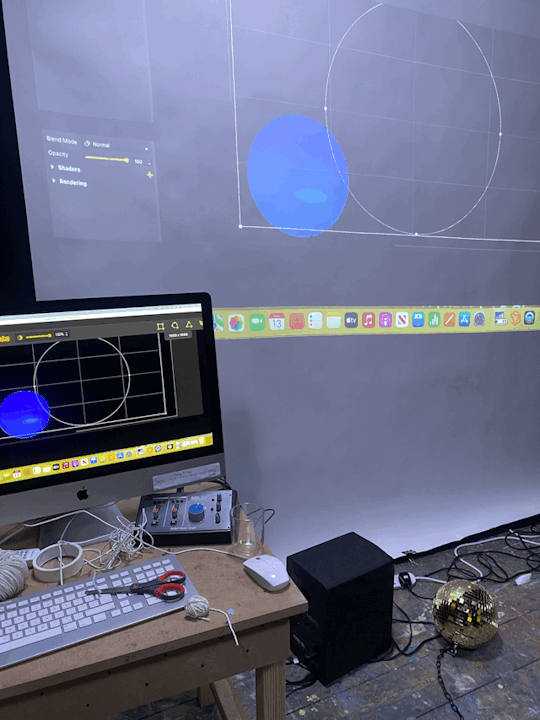
Friday 16th December
This was the final, in studio, session of semester one. In this session we were presenting our research, explaining our process and showing our final outcomes from the past few weeks. It was an interesting session listening through everyones experience and seeing their outcomes. There was a huge range of interesting outcomes like; simulations, interactive installations, AI, paper mache, VR and more. Despite being nervous, the presentation ran fairly smoothly. I think that the mini presentations we've done and all the collaborative work so far definitely helped in ensuring we were comfortable to present in the end. Though it was for a longer period of time it was still useful to know that we had done similar tasks before and so had that experience.
0 notes
Text
Week 12
Tuesday 6th December-
In this session I continued with the group powerpoint, I began adding in some of the photographs and the footage we'd captured in the previous week. I also began making a compilation video of the recorded footage that we got, this will make the video that we will project on to the bike wheel canvas next to the painted pieces. I completed this video in the morning ready for a trial run using the video mapping software in the afternoon. In the morning we also had group tutorials. We realised in the tutorials that we wouldn't be able to get the Minecraft world that we had made, into the VR headset. Though this wasn't what we intended, we decided the only other way to fully capture the world and use the 360 degree perspective was to record the world and then have it played back as a video during the presentation. Amie was able to record the world and capture it that showed it in the best way possible. This was another thing for me to later add into the presentation.
In the afternoon Sarah introduced me Rachel and Amie to the Heavy M Keys programme for video mapping. I completed the tutorial on the programme and we were then able to get the video I had made into the programme and map it to a circle shape, so that it projected in that shape onto the wall. This was just on the wall in the studio, we hope next session, to practice again in the dark space so that when the canvas is mounted alongside the dried painted pieces, we can map it again with ease.
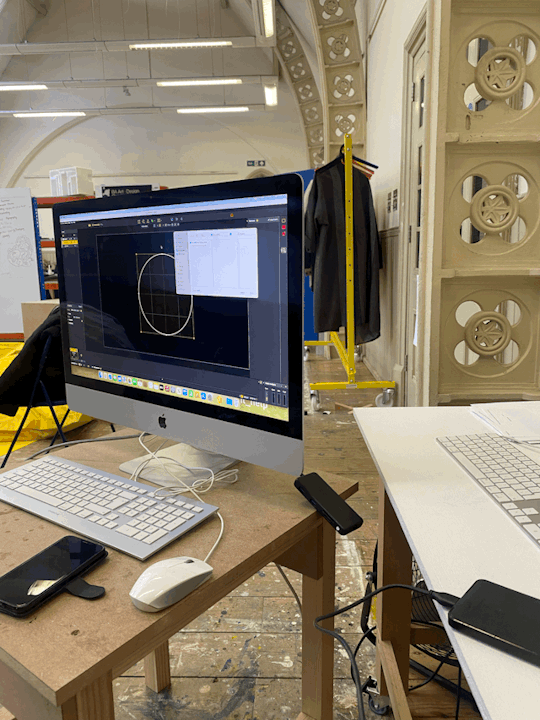
Friday 9th December
This session again was mostly about adding to the presentation. I continued to update it with the images we'd taken and the information we felt relevant for the presentation. I wrote about the objects and the design process and the approach we took to each of the labs.
Again in the afternoon we practised using the video mapping programme, however, this time in the dark space as this is where the video will be mapped when the outcome is fully mounted. This wasn't too difficult to do as we'd had that previous experience with it.

0 notes
Text
Week 11
Tuesday 29th November-
We began this week with a mini presentation of our digital lab progress. We spoke through the idea of combining the thought lab and digital lab, by capturing the notion of fear and technophobia in the world on Minecraft. We knew that in Minecraft you walk through as if your are physically in that world and so we though that links with Liz's digital object, that being the 360 degree camera. If we were to place the world into the VR headset the audience would experience this world and the 360 degree perspective firsthand.
In this lesson we had planned to use the dark space to paint and film the pieces of fabric that we had found in the studio. We used paints from the school of art that weren't in use, and began with the creative experimental painting. I started by using the decking wood to imprint on the fabric. Amie used the bike wheel and rolled and dropped it, leaving track and circular marks. We used the teacup and painted it so the circular shapes imprinted on the fabric. We also filled it with paint then dropped it, leaving interesting shatter explosive effects. We recorded the process and photographed the piece once finished. We got some really interesting images of the piece and the paint that was leftover on the objects.
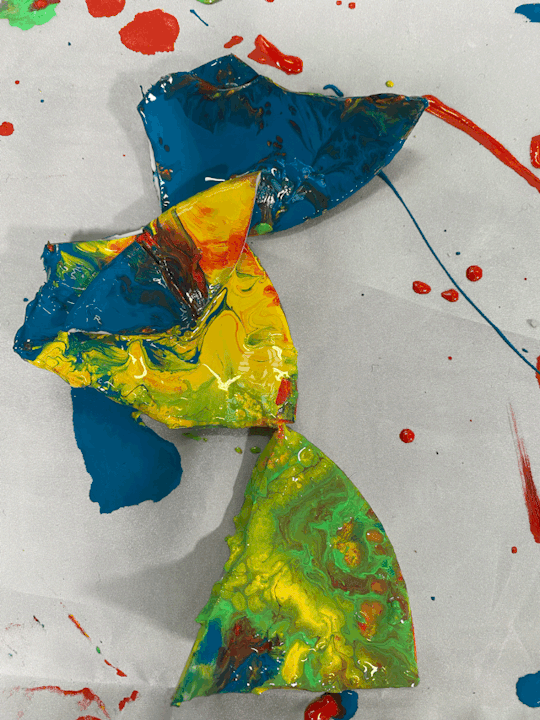



Friday 2nd December-
On Friday we continued with the experimental painting. We painted another piece of fabric, this time we were more cautious of the colours used, we used a neon paint that we had come across as we thought it may be interesting to test this with varying lighting colours. We also focused on the idea of smashing the cup filled with paint. We attempted this technique on the first piece however, because this was the first try and we had already used a variety of techniques, we didn't feel the full potential was achieved and so focused this technique on the next piece. This one was a fun one to make. We filmed the process again, as it will contribute to the full final video that will be projected next to the painted pieces. We used the blue light and the normal light throughout the making of this piece, it was quite exciting to see the piece transform and glow when the lights changed.
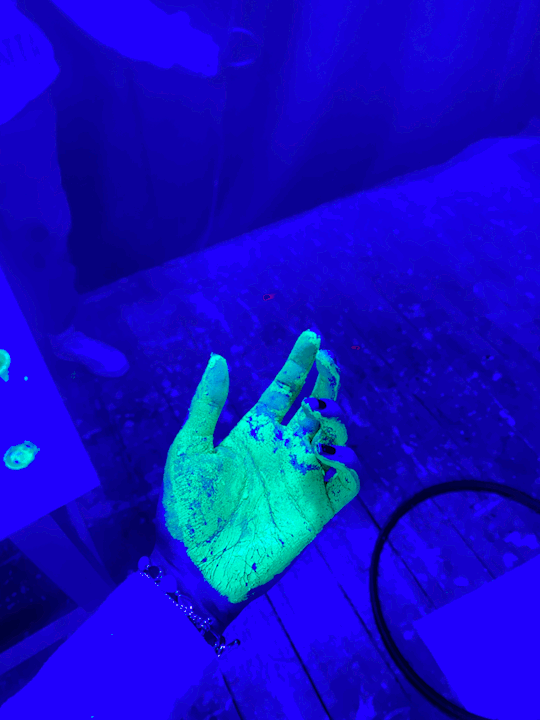

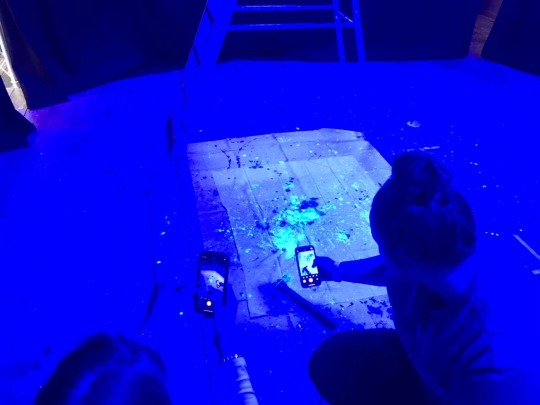


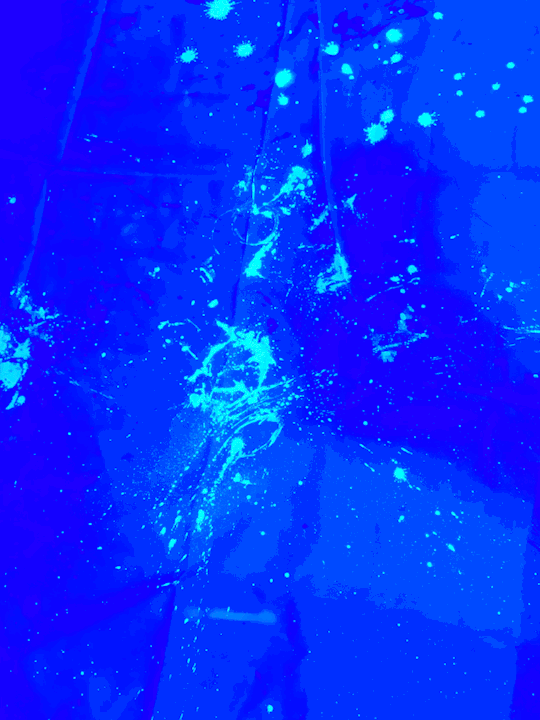
0 notes